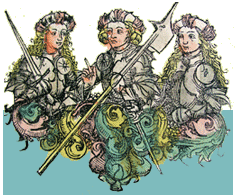A quick question
from Monday, August4th of the year2008.
Is there anything more heart-rending than seeing  somebody walking a dog, and the dog is carrying the leash in his mouth? I feel like that moment operates on a variety of different levels, but the one most touching to me is the dog taking an implicit command of his confinement. My experience, though, is that dogs who have this habit are happiest not to run away with the keys to prison, but to happily trot on with a sense of pride. I like it.
somebody walking a dog, and the dog is carrying the leash in his mouth? I feel like that moment operates on a variety of different levels, but the one most touching to me is the dog taking an implicit command of his confinement. My experience, though, is that dogs who have this habit are happiest not to run away with the keys to prison, but to happily trot on with a sense of pride. I like it.
I have been listening to this amazing Buxtehude cantata, Mit Fried Und Freud Ich Fahr Dahin. Buxtehude is the composer & organist whom Bach once famously walked 250 miles to hang out with. This cantata was evidently written on the death of Buxtehude’s father in 1674. Hermann Keller writes:
These two chorale movements, entitled by Buxtehude “Contrapunctus I and II,” are from the funeral music on the death of his father (1674) and are in quadruple counterpoint, i.e., the 4 voices can be mutually interchanged. In the “Evolutio” these possibilities are developed: in the 1st the soprano becomes bass, bass becomes soprano, alto tenor, and tenor alto; the whole is transposed into the dominant. The 2nd “Evolutio” brings (except for a few notes at the end) the mirror form; the voices are not only interchanged as in the first example but are also brought in inversion. source
Essentially, what this means is that Buxtehude took this chorale melody (which is a tune that most people would know, like a hymn), put it down, flipped it, and reversed it. The theme exists right-side upp and upp-side down. This sounds super clever-clogs, but in reality, the effect is the spiritual equivalent of being able to see your house from a plane: familiar but distantly pulsing. The most explicit example of this effect is five minutes in, when the sopranos slowly intone the melody.
[audio:03 Mit Fried Und Freud Ich Fahr Dahin.mp3]
Dietrich Buxtehude Mit Fried Und Freud Ich Fahr Dahin
Collegium Vocale, Jos van Immerseel, Orchestra Anima Eterna & The Royal Consort

10 Comments
August 4th, 2008 at 4:19 pm
You might wnat to check out some of the writings of Vicki Hearne (http://en.wikipedia.org/wiki/Vicki_Hearne) poet and animal trainer. (also http://query.nytimes.com/gst/fullpage.html?res=9B0DEEDB1E31F934A1575BC0A9679C8B63)
August 4th, 2008 at 10:39 pm
Oddly enough, I knew this guy who named his dog Buxtehude, and Buxtehude would do that: take his leash in his mouth as you describe.
In my recent reading, I’ve come across several accounts of slave owners sending their “most trustworthy” slave to catch a runaway in the northern states during the US slavery era. Not equating “pet custodianship” with slavery, but that is pretty heartbreaking.
August 5th, 2008 at 9:52 am
Maybe dogs don’t understand that the leash is what’s holding them back. Certainly, neither of my dogs understands that the leash can trip old people or that I am easily disabled if they run around me in circles. Oh. Maybe they do.
August 5th, 2008 at 11:02 am
Hey, too bad you can’t come and perform in Ottawa.
Who would you walk 250 miles for?
Thanks for the Buxtehude!
August 5th, 2008 at 12:38 pm
They don’t call her Missy “Buxtehude” Elliot for nothing.
August 6th, 2008 at 8:39 am
re the inversion in Buxtehude’s cantata:
It’s wonderful music; I hadn’t heard it before.
Most people who know Rachmaninoff’s “Rhapsody on a Theme by Paganini” probably don’t realize — as I had not until I read the book “Godel, Escher, Bach: An Eternal Golden Braid” by Douglas R. Hofstadter, many years after first hearing it — that the ravishingly beautiful slow, languorous theme about halfway through the piece is an exact inversion of the original theme, which is quick and jumpy. Knowing this somehow makes it even better.
P.S. The 4th iteration of Buxtehude’s original theme (the 2nd time the bass sings it, around the 4th minute) is already the inversion of it, before the soprano group sings it a minute later.
August 6th, 2008 at 9:35 am
I suppose it is too simple (and too serious) to see the dog as a metaphor for all creative artists who choose to work within received forms – who hold their own leashes, as it were.
August 6th, 2008 at 9:35 pm
One of my favorite examples of inversion is Holst’s First Suite fo’ Military Band, in the Chaconne.
He begins the piece with the melody in the low brass, and slowly moves it up the octave, exploiting many of the band’s textures, and then inverts it and sets the inversion in a minor key, completely changing the mood. And, after playing a while in the minor, he makes a slow move to major, ending it with striding chords.
woot.
I also think that we could safely compare Schoenberg’s forms (esp. his inversions of tone rows, etc.) to the dog holding onto the leash. He could push as far as he wants into atonality, but still holds on to forms with a Mozartian grip.
August 8th, 2008 at 10:14 pm
Gómsætt!
August 11th, 2008 at 3:42 pm
In German Titles, Only The Nouns Need To Be Capitalized.
I do look forward to discovering this cantata. Thanks for the tip!